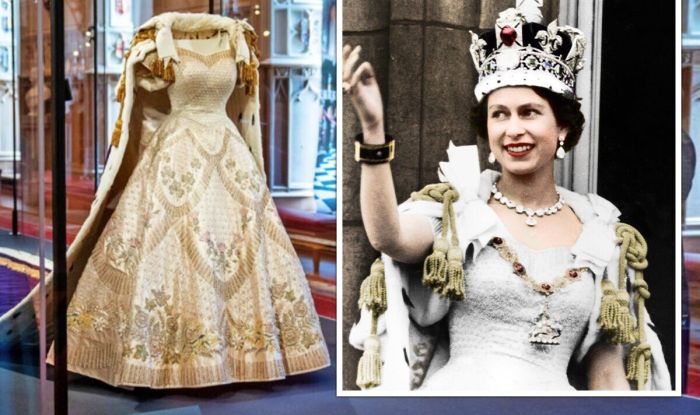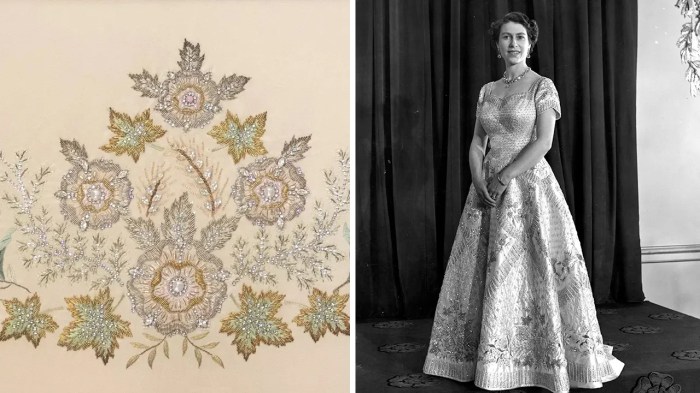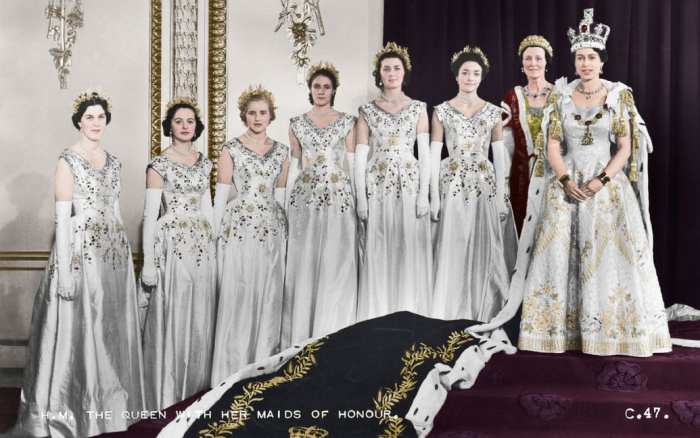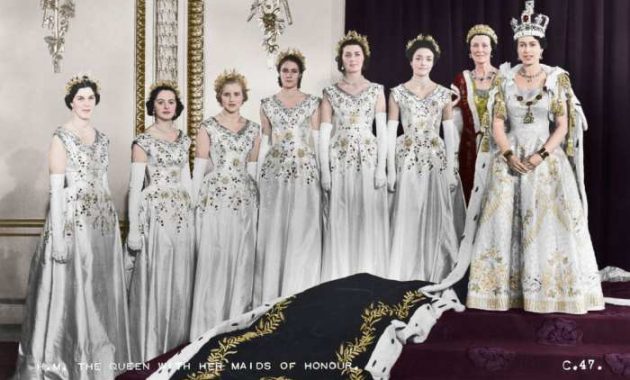Queen Elizabeth II’s Wedding Dress: A Timeless Icon
Coronation queen elizabeth wedding dress – Queen Elizabeth II’s wedding dress, a symbol of post-war optimism and enduring elegance, continues to captivate and inspire. Its design, fabric, and enduring legacy reflect not only a pivotal moment in British history but also a lasting influence on bridal fashion worldwide. This article delves into the creation, impact, and lasting significance of this iconic gown.
The Design and Creation of the Dress, Coronation queen elizabeth wedding dress
Norman Hartnell, a renowned British couturier, was commissioned to design the dress. He collaborated closely with the Queen to create a gown that reflected both her personality and the spirit of the time. The design process involved numerous fittings and meticulous attention to detail. The choice of ivory silk satin, a luxurious fabric, was symbolic of purity and elegance.
The gown featured a full, flowing skirt, a fitted bodice, and a long train. The design incorporated subtle details such as delicate floral embroidery and seed pearls, reflecting the post-war era’s emphasis on delicate beauty. The high neckline and long sleeves were considered appropriate for a royal wedding at the time. The dress also incorporated elements that hinted at the nation’s recovery from the war, subtly weaving in the hopes for a brighter future.
| Dress | Fabric | Silhouette | Embellishments |
|---|---|---|---|
| Queen Elizabeth II | Ivory silk satin | Full skirt, fitted bodice | Floral embroidery, seed pearls |
| Princess Diana | Silk taffeta | Puffed sleeves, voluminous skirt | Lace, antique pearls |
| Kate Middleton | Satin | Fitted bodice, full skirt | Lace applique, hand-stitched details |
| Meghan Markle | Silk crepe | Simple, A-line | Minimalist embellishments |
The Fabric and Construction of the Dress

Source: co.uk
The dress was constructed using high-quality ivory silk satin, chosen for its luxurious sheen and drape. The intricate embroidery and beadwork, meticulously crafted by hand, added to the gown’s overall opulence. The creation of the dress involved skilled seamstresses who worked tirelessly to ensure its perfection. Challenges included the sheer volume of fabric and the intricate detail of the embroidery, but these were overcome through meticulous planning and craftsmanship.
The design was carefully constructed in layers, ensuring a smooth and elegant drape.
- Multiple layers of silk satin for volume and drape
- Intricate floral embroidery using silk threads
- Thousands of seed pearls sewn by hand
- Boning in the bodice for structure and support
- Multiple seams to create the fitted bodice and full skirt
- A long train attached to the bodice
The Impact and Legacy of the Dress

Source: foxnews.com
Queen Elizabeth II’s wedding dress had a profound and lasting impact on bridal fashion. Its elegance and timeless design continue to inspire designers and brides alike. The dress’s design elements, particularly the full skirt and delicate embroidery, have been frequently replicated and reinterpreted in subsequent wedding gowns. Its enduring popularity is a testament to its classic beauty and enduring appeal.
- 1947: The dress is designed and created by Norman Hartnell.
- November 20, 1947: Queen Elizabeth II marries Prince Philip in Westminster Abbey wearing the dress.
- 1950s-present: The dress inspires countless bridal gowns and remains a style icon.
- 2000s-present: The dress is featured in numerous documentaries and books on royal fashion.
- Present day: The dress remains a significant symbol of royal history and continues to inspire.
The Coronation and its Connection to the Wedding Dress

Source: thedailybeast.com
While vastly different in style and purpose, both Queen Elizabeth II’s wedding dress and coronation robes reflect the grandeur and symbolism of her reign. The wedding dress represented a personal union and a promise of a new era, while the coronation robes signified her formal ascension to the throne. However, both garments shared a sense of regal elegance and utilized high-quality fabrics and intricate craftsmanship.
The historical context of both events underscores their importance in shaping the Queen’s public image and legacy. The wedding dress projected an image of youthful grace and optimism, while the coronation robes emphasized majesty and authority. The visual impact of the Queen in her wedding dress was one of youthful radiance. The ivory satin created a soft, luminous glow against her skin, while the full skirt and delicate embroidery created a sense of romantic elegance.
The overall impression was one of refined beauty and understated elegance.
Visual Representation of the Dress
The dress featured a classic A-line silhouette, with a fitted bodice that accentuated the Queen’s waist and a full, flowing skirt that extended into a long train. The ivory color was chosen to symbolize purity and innocence, a traditional choice for royal brides. The floral embroidery, crafted from silk threads, depicted delicate sprigs and blossoms, adding a touch of romantic detail to the overall design.
These were scattered across the skirt and bodice, subtly enhancing the dress’s luxurious texture. The seed pearls, meticulously sewn by hand, shimmered subtly, adding a touch of understated sparkle. The texture of the dress was smooth and luxurious, the silk satin falling in elegant folds and ripples, creating a visually stunning effect.
FAQ Compilation: Coronation Queen Elizabeth Wedding Dress
What type of silk was used in Queen Elizabeth’s wedding dress?
Heavy ivory duchesse satin.
How many people worked on the dress?
A team of several skilled seamstresses worked under Norman Hartnell’s direction, though the exact number isn’t publicly known.
Where is the wedding dress now?
It is part of the Royal Collection and is occasionally displayed.
Queen Elizabeth’s coronation gown, a masterpiece of ivory satin, remains iconic. However, contemporary brides are exploring a wider palette, with some choosing bolder options like a stunning bride purple wedding dress , a far cry from the traditional white. The contrast highlights the evolution of bridal fashion since the Queen’s historic coronation, demonstrating how personal style continues to shape wedding attire.
What was the estimated cost of the dress in 1947?
The exact cost isn’t publicly available, but considering the materials and labor, it would have been quite substantial, even adjusted for inflation.

